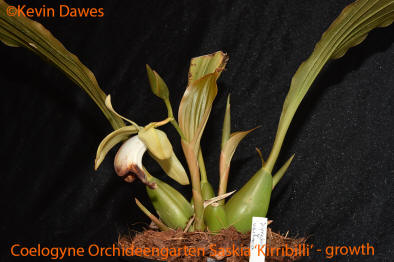This spectacular new primary Coelogyne hybrid was only registered in 2014. It was bred in Germany by M Karge-Liphard. It is another new registration in an impressive list of new Coelogyne hybrids being released under this label in Germany
The choice of parents, Coelogyne xyrekes and Coelogyne usitana, was easy given the beauty, uniqueness, hardiness and large flowers of both. Coelogyne xyrekes is famous for its unusual mushroom pink colouring and huge dark lip. Coelogyne usitana was only officially described in 2001 and was immediately hailed for its incredibly dark lip, large flower and ability to keep on adding one more flower to its spike for many months - up to 20 flowers over many months!
In this hybrid Coelogyne Xyrekes has been dominated by its partner. Coelogyne xyrekes has suppressed the green tinge in the sepals and petals, suppressed the dark colouring on the outside of the lip, suppressed the orange/gold tones of the column and even passed on its bronze tinge to the leaves. Nevertheless, the result is a large 8 - 9 cm wide flower with massive areas of rich tobacco colouring on the lip and column.
Negatives: Both parents are from tropical areas so this orchid will need a warm, humid dappled shade in preferably a hanging pot because the flowers hang downwards. Hanging or placing a pot up high will enable the beauty of the flowers to be appreciated more fully.
Rating: ♦♦♦♦♦ This is a very attractive addition to this group of Coelogyne hybrids.
Registered: 2014 by M. Karge-Liphard
I have also produced this hybrid in Australia. Under international naming conventions, anyone duplicating a hybrid that has already been registered must use the same allocated name given by the Royal Horticultural Society. Because it takes 5 or 6 years to grow a Coelogyne hybrid it is very understandable that another grower may be a year or two ahead of another and be the first to register a hybrid. An extra tag in inverted commas may be added to the official name, such as "Kirribilli" in my case. A major benefit of duplicating a hybrid is that it may be available in other countries much earlier - in my case, in Australia.
NB: The parents used in a remake of the original may not look the same as the original parents because of natural genetic variation. This fact can often be used to advantage by selecting superior strains to the original or selecting some other trait - such as colour variation (in my case it was simply a timing accident!).
| < Coel Neroli Cannon | Coel Rebekah Banks > |

